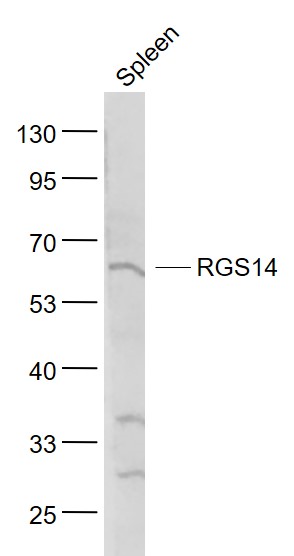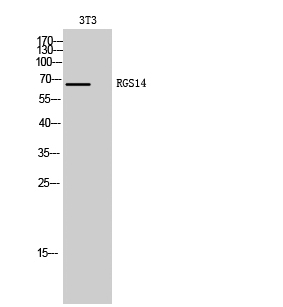
WB analysis of Jurkat lysate using GTX15720 RGS14 antibody, C-term. Dilution : 0.5microg/ml Loading : 35microg protein in RIPA buffer
RGS14 antibody, C-term
GTX15720
ApplicationsWestern Blot
Product group Antibodies
TargetRGS14
Overview
- SupplierGeneTex
- Product NameRGS14 antibody, C-term
- Delivery Days Customer7
- Application Supplier NoteWB: 0.5-2microg/ml. *Optimal dilutions/concentrations should be determined by the researcher.Not tested in other applications.
- ApplicationsWestern Blot
- CertificationResearch Use Only
- ClonalityPolyclonal
- Concentration0.50 mg/ml
- ConjugateUnconjugated
- Gene ID10636
- Target nameRGS14
- Target descriptionregulator of G protein signaling 14
- Target synonymsregulator of G-protein signaling 14
- HostGoat
- IsotypeIgG
- Protein IDO43566
- Protein NameRegulator of G-protein signaling 14
- Scientific DescriptionThis gene encodes a member of the regulator of G-protein signaling family. This protein contains one RGS domain, two Raf-like Ras-binding domains (RBDs), and one GoLoco domain. The protein attenuates the signaling activity of G-proteins by binding, through its GoLoco domain, to specific types of activated, GTP-bound G alpha subunits. Acting as a GTPase activating protein (GAP), the protein increases the rate of conversion of the GTP to GDP. This hydrolysis allows the G alpha subunits to bind G beta/gamma subunit heterodimers, forming inactive G-protein heterotrimers, thereby terminating the signal. Alternate transcriptional splice variants of this gene have been observed but have not been thoroughly characterized. [provided by RefSeq, Jul 2008]
- Storage Instruction-20°C or -80°C,2°C to 8°C
- UNSPSC12352203





